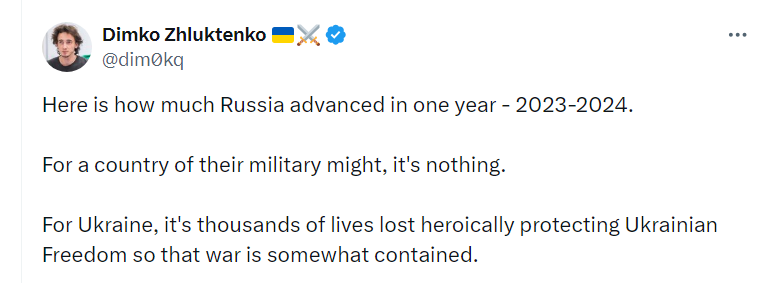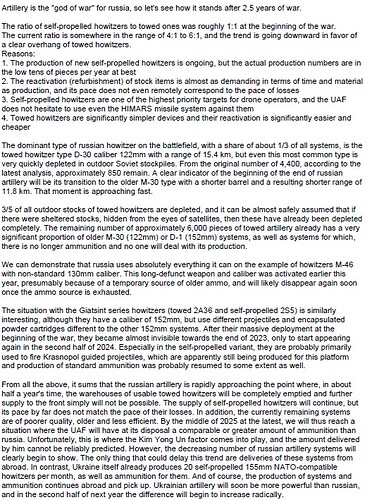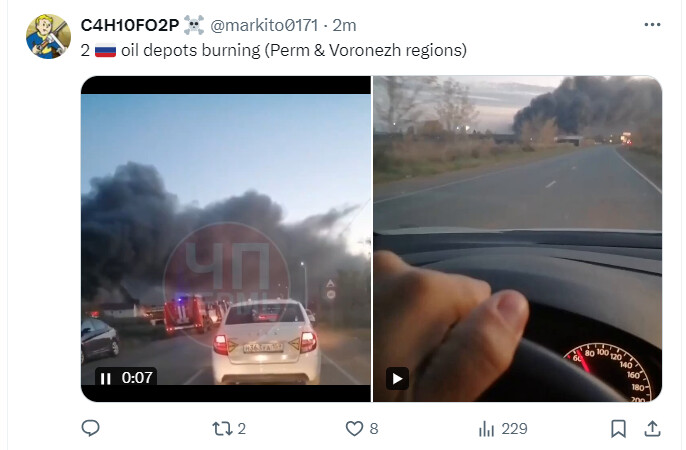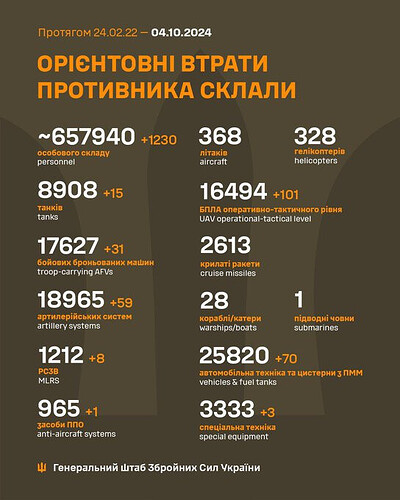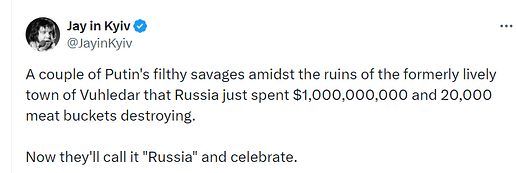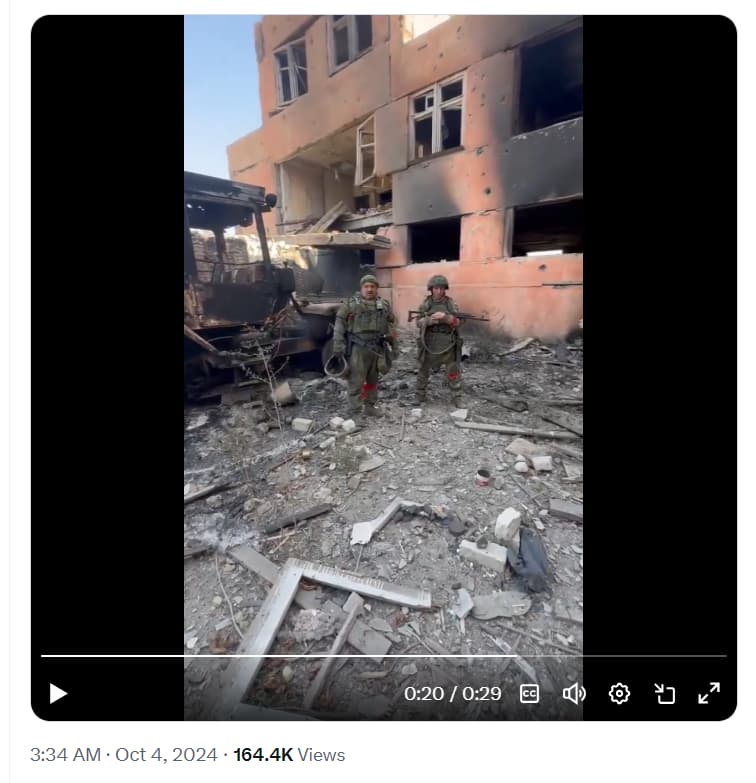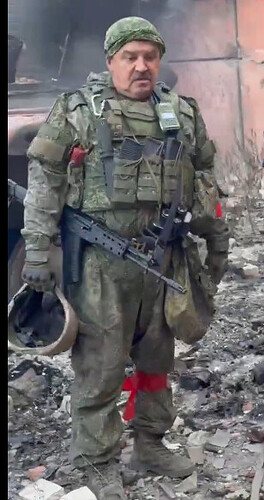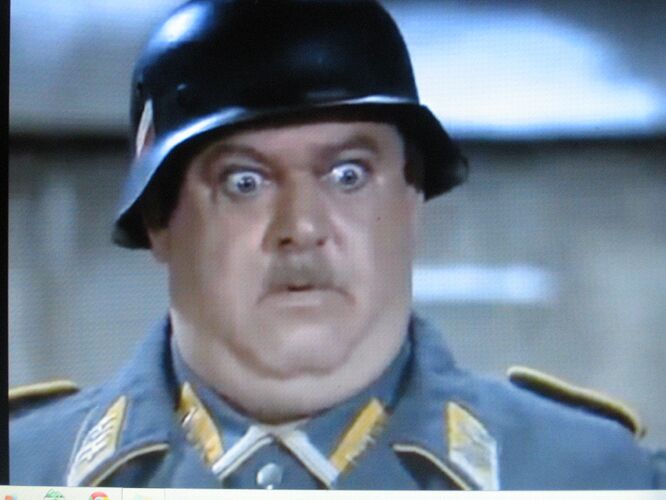Bumpski.
I don’t think I saw news of this posted already.
Ukraine ATACMS Strikes Destroy Long-Range Russian Radar Station Worth $100M
Published Oct 03, 2024 at 4:31 AM EDTUpdated Oct 03, 2024 at 7:45 AM EDT
Ukrainian forces have struck a valuable Russian radar station using U.S.-supplied long-range missiles, Kyiv said on Thursday, in a move that could disrupt Moscow’s air defenses and open up Russian targets to further attacks using sophisticated Western weapons.
Ukraine destroyed a Russian Nebo-M long-range radar station in an unspecified location, Kyiv’s military said in a statement posted to social media, without giving further details.
“Its destruction significantly reduces the ability of the Russian army to detect, track and intercept aerodynamic and ballistic targets,” Ukraine’s military said.
Newsweek could not independently verify the report and has reached out to the Russian Defense Ministry for comment via email.
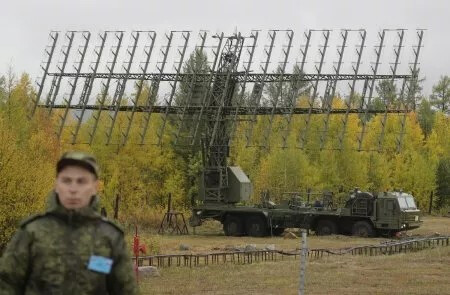
A Russian soldier stands in front of a Nebo-M radar in Eastern Siberia, Russia, on Wednesday, September 12, 2018. Ukraine destroyed a Russian Nebo-M at an unspecified location, Kyiv’s military said in a statement posted to social media on Thursday.
Reports from late May suggested Ukraine had used U.S.-donated Army Tactical Missile System (ATACMS) ground-launched missiles to target a Nebo-M radar in a Russian-controlled area of the eastern Ukrainian Luhansk region.
The Nebo-M is “very complex,” Ukraine’s military said on Thursday. Russia has just 10 of such radar stations remaining, Kyiv said, putting the cost of each system at more than $100 million.
Russian state media has claimed the radar as able to detect enemy aircraft and ballistic missiles at a distance of 1,000 kilometers, or around 620 miles.
Taking out the radar station will help Kyiv to effectively wield its British Storm Shadow and French SCALP cruise missiles, which are launched by aircraft, the Ukrainian military added.
Ukraine has received several batches of the ATACMS missiles and an unknown number of Storm Shadow and SCALP missiles, but Kyiv has consistently requested further long-range strike weapons like these to fend off Russia’s creeping advance in the east of the country.
Something was posted yesterday, see post 2633 by Nexta.
This seems a bizarrely long article with a strange premise considering Russia has run aground for two and a half years against Ukraine, let alone a full mustering of NATO.
I doubt the remaining Russian airforce would last more than week against NATO.
Due to their huge size, their land forces would be more of a challenge, however, Russia has wasted way it’s elite forces and really has nothing more than meat-wave tactics.
And lets not even get into the joke that is the Russian navy.
I’m still trying to get my head around what is now a reasonably long term offensive operation by Ukraine into Russia around Kursk. It remains a very intriguing political, strategic and tactical move.
Truly hope those predictions bear out.
Maybe the. Navy in the Black Sea, but strong elsewhere. Turkey holds the key to access to the Black Sea
The Russian navy in the Black Sea is almost nonexistent.
Their fleet at their blue-water ports isn’t a whole lot stronger.
Their submarine fleet is probably their biggest asset
- Ballistic Missile Submarines (SSBNs): 16
- Nuclear-Powered attack submarines (SSNs): 14
- Nuclear-powered cruise missile submarines (SSGNs): 11
- Diesel-electric attack submarines (SSKs): 23
But compare that to the USA + UK it’s not that scary, and I question if more than 50% is actually operational.
50% would be optimistic.
Good question.
Russians Do Break: Historical and Cultural Context for a Prospective Ukrainian Victory
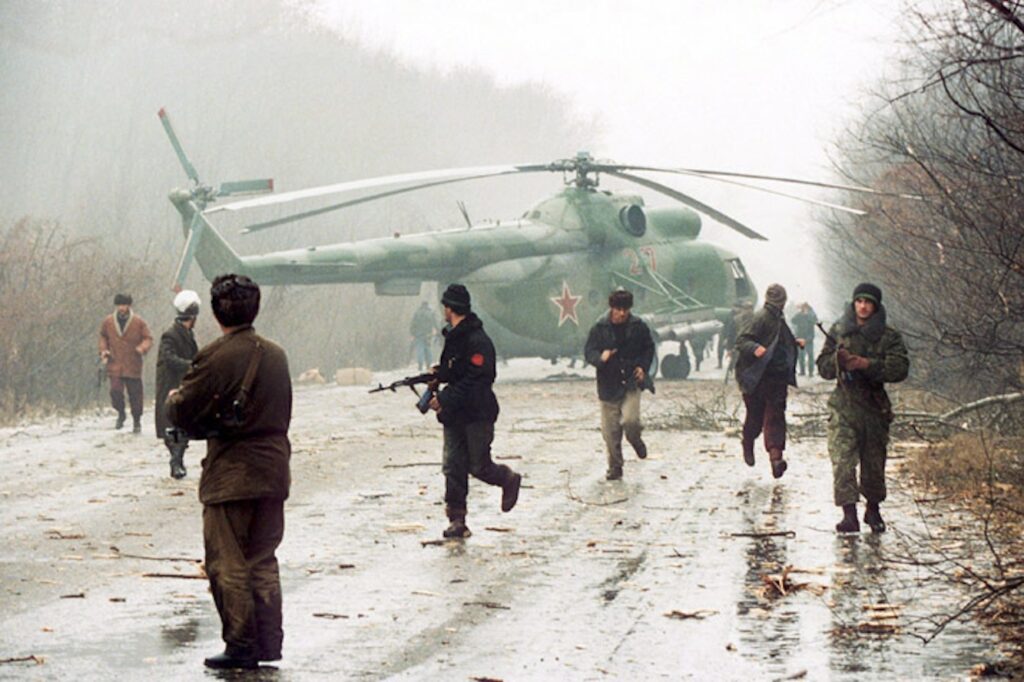
For major wars like the one being fought between Russia and Ukraine, the military, the people, and the state interact with one another to constitute a collective national will to fight. In most wars, one side loses its will to fight and is forced into an unfavorable negotiating position; it accepts a defeat short of annihilation.
Russia can be broken in Ukraine and thereby forced to accept this kind of negotiated defeat. I argue here that the approach Ukraine and its Western allies are taking — the combined attrition of Russia’s military and the compression of its economy — has a good chance of succeeding if it can be sustained.
To understand how Russia can be brought to its knees, policymakers and the public first need to understand the historical and cultural influences that strengthen Russian will to fight. These admittedly discouraging factors go a long way toward explaining why Russia has not yet quit more than two years into this extraordinarily costly war.
But all people have limits. Despite benefitting from the longstanding historical and cultural strengths I describe in this article, Russia quit in Afghanistan in the 1980s, and it quit in Chechnya in the 1990s. History informs forecasting. In the case of the Ukraine War, a realignment of historical factors suggests there are good prospects for Ukrainian and Western victory.
Skewed Western Perceptions of Russians as Superhumans
When I proposed a study of Russian will to fight to a U.S. general officer in 2015, he told me that “Russians never quit.” While his assumption about the Russians was provably wrong, it also was understandable. At least from a modern Western perspective, seemingly mindless sacrifices made by Russian soldiers throughout modern history — particularly in World War II and in Ukraine since 2022 — can appear prima facie to be almost superhuman.
Since the full scale invasion of Ukraine in 2022, an endless barrage of videos has shown us waves of Russian troops launching themselves into Ukrainian defensive lines only to be blasted apart by artillery and drones, shredded by cannon and machinegun fire, and then routinely abandoned on the field by their commanders. Even after these repeated catastrophes, new waves of soldiers have trundled over flat ground in suicidal linear columns, all in broad daylight, to meet similar ends. In a ghastly series of Kiplingesque motifs, wounded Russian soldiers have “rolled to their rifles” and killed themselves (or blown themselves up with grenades, or even slit their own throats) seemingly without a moment’s hesitation.
On the home front, Russian President Vladimir Putin appears implacable as ever. Since 2022, hundreds of thousands of Russian men have volunteered or dutifully reported for service in waves, feeding what now looks even to the Russian public to be a meatgrinder offensive in the eastern Donbas region of Ukraine. Two years into a war that has buckled their economy, killed or wounded perhaps over 300,000 servicemen, and produced many notable battlefield defeats, civilian willingness to back Putin’s war appears at least on the surface to be unwavering. Keeping in mind the poor conditions for survey work in Russia, Levada Center polling showed 77% support for the war in the beginning of 2024.
Many Western analysts could not image modern 21st century Western soldiers recklessly throwing their lives away or military leaders so cruelly ordering them forth with such seeming carelessness. Nor could they imagine today’s Western citizens rallying with such little sustained public opposition behind such a seemingly purposeless and unremittingly bloody war.
Given the assumption that Russians have an inexhaustible willingness to fight, public discussions of the Ukraine War have focused on other questions: Will the Russians run out of Soviet-era war stocks? Will their economy collapse? Will Ukraine’s Kursk incursion succeed or backfire? How many casualties can the Russians sustain? Will they overthrow Putin? This all has devolved into a flailing roller-coaster ride of excited prospects and dashed hopes, and then inevitably to exhausted patience. A more nuanced conversation about the cultural and historical factors influencing Russia’s will to fight can offer grounds for more optimism — before Western popular support for Ukraine fades even further, and before Western leaders lose their own will to fight.
The Historico-Cultural Context
To better understand the will to fight of any nation as a Clausewitzian trinity consisting of the army, the people, and the state, it helps to appreciate its history and culture. This approach requires some humility. History and culture can help us understand influences on behavior but they can easily be overstated; nothing accurately predicts complex human behavior in war. This historico-cultural context is a necessary starting point to help identify the point at which the Russians are more or less likely to quit.
A great deal of scholarship about Russian history and culture focuses on several key factors that shape the country’s approach to conflict: trauma, nationalism, spirituality, and fatalism. All four of these factors are closely interwoven and effectively inseparable: Trauma feeds fatalism, fatalism and spirituality feed nationalism, nationalism reinforces fatalism, and so on.
All these compelling factors emerge repeatedly in modern Russian propaganda, literature, video, and, perhaps most importantly, in the fleeting but often forthright insights from Russian civilians and soldiers. They culminate in what may best be described by the late scholar Evgeny Yasin as a “tragic passivity” that has thus far rendered many Russians vulnerable to Putin’s finely tuned and omnipresent manipulations.
Trauma
Perceptions of trauma are visible as a deep current in Russians’ shared history. They also are anchored in a singular modern event: the 1991 collapse of the Soviet Union. Many Russians believe theirs is a nation of eternal and passive sufferers. And, of course, there are grounds for this belief. Despite the state’s increasingly vast access to resources from the 19th through the 21st centuries, average citizens of Russia and the Soviet Union lived in a general state of poverty and powerlessness.
Patrimonial state control ensured that average Russians outside of the Moscow bubble — mechanics, teachers, farmers, bricklayers, store owners, oilfield workers, etc. — too often existed at the whim of a fickle and purposefully brutal state. To some extent, these conditions continue to exist in Russia in 2024. Rural and small town Russians, and many less-well-off urban Russians, are long accustomed to being manipulated and abused (really, traumatized) by state officials at all levels. Their general expectations for an equitable and hopeful life are, to be fair, broadly tempered.
Perhaps more directly relevant to understanding Russian will to fight in Ukraine is the trauma resulting from the collapse of the Soviet Union and its impact on Russian society and the economy, and on Russian leaders. Experts on modern Russian culture are clear about the impact of the immediate post-Soviet period: As Americans ask themselves if economic sanctions will squeeze the Russians to the point of surrender, they must put ourselves in the shoes of Russians who suffered through the trauma of the 1990s, and also in the shoes of the children who have acquired that perception from their parents.
The collapse of the Soviet system proved disastrous for Russia. In the decade following the transition to an effectively capitalist free-market economy, production plummeted, inflation skyrocketed, the Russian currency tanked, and the standard of living for average Russians fell markedly. Mortality from alcoholism may have increased sevenfold just from 1991 to 1994, and aside from the pirate-oligarch nouveau riche, life expectancy dropped. Russians’ sense of national purpose and hope for the future declined. Russian culture atomized, necessitating a national rebirth.
Putin, who was himself deeply traumatized by the Soviet Union’s collapse, crafted that rebirth. Buoyed by conveniently high extractives revenues, Putin revitalized Russia’s economy. Employing what he once referred to as “cultural therapy,” he recentralized Russian society around nationalism and messianic spirituality (see below) and gave both ethnic and non-ethnic Russians living within the state’s borders a renewed sense of collective purpose. He continues to frame Western sanctions and support for Ukraine as a conspiracy intended to relegate Russia to the misery of the 1990s.
In interview after interview, many Russians — but certainly not all — share their belief that Putin saved them from their post-Soviet trauma. More importantly, they view their current prospects in the mid-2020s in relative contrast to the traumatic 1990s, and also to the ugly decline of the late 1980s. Therefore: As bad as it can get now or in the near future, at least it will be relatively better than it was.
Defensive Nationalism
Modern Russian nationalism, like that of many other countries, builds from both a narrative of existential threat and a messianic perception that the Russian people are spiritually anointed universal exemplars and, therefore, justified in expanding their power. Defensive nationalism helps us understand the willingness to make extraordinary sacrifices in any war, while spirituality and messianism — discussed further in the next section — help us understand how Putin and many Russians justify and are therefore motivated to win the Ukraine War.
Russians’ cultural memory of collective trauma is closely linked to their sense of perpetual external threat. Here too, history provides ready examples. For nearly a millennium, the state now known as Russia has been under either direct siege or the perceived threat of siege. It suffered repeated assaults dating at least from the 13th century Mongol invasion that destroyed Moscow, and its history includes at least six other invasions that directly threatened the city that became the Soviet, then Russian, capital.
No historical threat is more relevant to the contemporary Russian will to fight than the Nazi invasion of the Soviet Union in World War II. Reminders of the Great Patriotic War are omnipresent in daily Russian cultural life, reinforced in formal education, popular entertainment, ceremonies, and the ubiquitous statues and tributes to veterans and casualties. Most Russians are acutely aware of the roles their grandparents and great-grandparents played in the war. Putin continues to build new monuments to anchor today’s Russians in their mid-20th century past.
While Putin does not deserve all the credit for centralizing the Great Patriotic War in Russian consciousness — Russian pride and remembrance are longstanding and broadly lived — he certainly has leveraged this cultural memory to both shape and sustain the collective rationale for the Ukraine War. Putin has repeatedly worked to build a rhetorical bridge linking historical traumatic threats to the manufactured threat ostensibly posed by Ukraine.
Themes of unquestioning sacrifice are central to this anchored collective remembrance of the Great Patriotic War. Probably over 25 million Russian soldiers and civilians died in World War II. Russians have long perceived this sacrifice as an absolute necessity. Westerners might view Russians’ fond remembrance of such an enormous loss as perverse, but for many Russians the losses themselves are an almost unquestioned point of pride.
Modern Russian nationalism emphasizes the perceived collective need to fend off perpetual existential threats. Successfully fending off these threats has required sacrifice. Russian victory typically emerged only following extensive trauma; say, after a costly Mongol, Polish, or German invasion. Cultural memory of the Great Patriotic War organizes and frontloads this powerful narrative of nationalist sacrifice. So when the invasion of Ukraine is likened to a “Little Patriotic War,” or in any way compared to World War II, then collective, defensive, nationalist sacrifice is firmly established as an expectation for victory.
Orthodox Spirituality and Messianism
Russian spirituality influences will to fight in the Ukraine War through common interpretations of Russian Orthodox doctrine, the Russian Orthodox Church’s direct support of Putin’s war narrative, and its historical messianism. Russians certainly do not follow church doctrine in lockstep — many believers are ambivalent about its least flexible precepts — but orthodoxy plays an influential role in Russian life and its modern moral discourse.
This influence reinforces Russian patrimonialism. Individual will, or choice, is viewed by some church leaders and parishioners as sinful. In 2000, Archpriest Vladislav Sveshnikov wrote: “The principle of ‘I will’ is one of the dominant principles of sinful existence.” So at least from this perspective, Russia’s broader patrimonial culture — in the case of the church a literal patriarchy — and obedience to power are continuously reinforced.
Spiritual obedience and the subjugation of individuality transfer directly to the state, which historically has subsumed the Orthodox Church and applied spirituality to achieve its own ends. Therefore, when the church declared Russia’s violent and illegal attempt to annex Ukrainian territory a “holy war,” indelibly linking church to state, many Russians may have been receptive.
Putin had previously enlisted the church in building a rationale for invasion well before 2022. Church leaders also declared Putin’s 2015 intervention in Syria a holy war. Building from a longstanding link between Russia’s church and its armed forces, Putin ensured that the Russian military closely integrated Orthodox Church chaplains, rituals, iconography, and spiritual idealism into military life.
In his ongoing sermons, Russian Orthodox Church Patriarch Kiril — who is allegedly a former KGB officer or asset — routinely frames soldiers’ sacrifices in Ukraine as glorious patriotic duty. Kiril extends his exhortations to the entire Russian population, describing their continuing will to support the war as “spiritual mobilization.”
At the national-collective level, broader spirituality anchored in the church feeds into ethno-nationalist messianism. This complex factor can be briefly summed up as a collective belief that Russia is a great power ordained with spiritual purpose to lead at least the Eurasian landmass. While a sense of messianism may be unevenly shared across the Russian populace, it helps Putin activate the other facets of spirituality and nationalism to reinforce the Russian will to fight.
Fatalism
All of these key factors (and others not listed here) contribute to a sense of fatalism. Many Russians — influenced by cultural memories of trauma and threat, conditioned by church and state through patrimony and fear to be obediently sacrificial, and motivated by genuine spirituality and nationalism — are, at least for now, prepared to accept whatever fate may hold in Ukraine and in the broader struggle against the West. They practice this fatalism through abdication and sacrifice.
Abdication is constantly evident in the blind acceptance of state control. In many of the more than 1,000 street interviews compiled by Daniil Orain in Moscow, other cities, and various rural areas since 2022, many Russians make plain that they willingly and purposefully submit to whatever policy on any subject the state might enact. Those in Orain’s videos who still openly disagree with the war — there are surprisingly many despite the looming threat of arrest — do so with the verbal equivalent of a shrug.
Sacrifice is constantly evident on the battlefield in Ukraine, where soldiers fatalistically submit to horrific treatment by their own leaders and fellow soldiers, hopeless combat missions seemingly designed to kill them, and unending deployments that may now require frontline service until either victory or death. While they routinely complain, and while some flee or surrender, at least through late 2024, hundreds of thousands of Russian soldiers were still demonstrating the daily will to fight, act, or persevere.
So When, and Under What Circumstances, Might the Russians Quit?
These worrisome descriptions mitigate toward a continuing Russian will to fight over time. However, history points to useful examples that help us understand when abdication and sacrifice might be tipped over into defeat. As I wrote up front, Russians do break. They have broken on the battlefield, including in Ukraine in late 2024. They broke on the home front during the Afghanistan and first Chechen wars. And Putin is breakable. While he is deeply fixated on Ukraine, he is also a creature of consummate self-interest. Self-interest is a potential weakness.
First, look to the battlefield. Well over 5 million Red Army soldiers surrendered to the Germans in World War II. Probably thousands more surrendered to irregular Chechen fighters in the mid-1990s. Data on total Russian prisoners of war in Ukraine is not reliable, but at least thousands of Russians have lost the will to fight and surrendered. Some broke even during the 2022 invasion. Entire units collapsed and fled in Kharkiv later that year. Probably over 600 Russians surrendered in Kursk just in the first weeks of the 2024 incursion. Russian soldiers can and do break.
On the home front, Russian civilians hit breaking points during both the Soviet and post-Soviet eras. As the Soviet war in Afghanistan ground on beyond its second year, it appeared that a combination of casualties (perhaps only one-tenth of those suffered thus far in Ukraine), increasing economic decline, and a general loss of belief in the war’s purpose took their toll. Recruiting and conscription numbers fell, and eventually Soviet leaders came to view the war as a “bleeding wound.” They withdrew in defeat. Catastrophe in Chechnya in 1994 also was fed by, and in turn led to, wavering Russian will to fight. These were entirely rational reactions to bad policies, bad treatment of soldiers, and bad economic conditions.
Putin has a breaking point, or at least a point at which he will settle on terms he finds unfavorable. While he presently retains dominant control over the state and enjoys at least an imposed version of popular support, Putin is aging and may be weakening. His surprisingly passive and initially incoherent response to Yevgeny Prigozhin’s revolt in 2023 caused a reexamination of his carefully constructed aura of invulnerability. Putin’s equally lethargic response to Ukraine’s 2024 Kursk incursion and his increasingly fantastical claims about Russia’s economy reinforce perceptions that he may be hurting.
So where does this all lead? While history is not necessarily predictive, at least the cases of Afghanistan and Chechnya (in 1994) suggest that Russia’s biggest vulnerability may lie at the intersection between battlefield casualties and economic strain.
Russian leaders appear to be aware of this worrisome problem in Ukraine. Generals are doing their best to hide casualties and keep wounded and distraught soldiers from returning home where, like the Afghansky of the 1980s, they might undermine popular support. They are desperately trying to use mercenaries, convicts, foreign troops, and unempowered mobilized troops to soak up casualties in order to keep their contract army intact. But Russia may be running out of cannon fodder. Military personnel costs are skyrocketing. Meanwhile, Putin is doing his best to maintain a veneer of economic normality. But his economy is almost certainly suffering under Western sanctions and market isolation.
… More …
Ben Connable, PhD is an independent research leader, adjunct professor of security studies at Georgetown University, and author of the forthcoming book, Ground Combat: Puncturing the Myths of Modern War.**
Girkin recently dropped another doom-post from the Gulag. Here it is: translated, fresh and 100% organic.
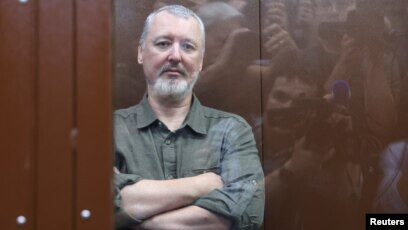
“Regarding the question of assessments/analysis of the situation - I still receive too little information for reliable “tactical” forecasts.
“Strategically” everything is bad - if the “bet on Trump” (which in my opinion was a failure from the start, but I do not insist on 100% reliability of my opinion) does not work out - then the next year (or even the end of the current one) will become a very serious test for our country.
I have repeatedly voiced the reasons for this even before my arrest (long before it):
— the “imitation” style of leadership and state administration led to the fact that “on paper” the Russian Federation looked extremely impressive in all respects (including in terms of military power).
In reality, a significant part of our power (very significant in some places) turned out to be “inflated”. Now the needs of the war far exceed the capabilities of our military-industrial complex, and the war has long ago “eaten up” or is “finishing to eat up” all the reserves of new weapons.
The same applies to trained human resources, which for 2.5 years were spent (and are still being spent) as if they were endless and inexhaustible. While the war has already “eaten up” the main “trained”(and relatively painlessly torn away from the economy) human resources without a trace.
— the wretchedness (to the point of complete absence) of strategic planning and the lowest quality of tactical planning have already led us to a complete stalemate (both in strategy and tactics), loss of initiative on the level of “amoebic reaction to irritants” — i.e. the military and industrial machines react to problems only at the moment when these problems have already become critically dangerous.
— There was no talk of making any long-term forecasts 2.5 years ago, and there is none now (which is not surprising, given the “amazing preservation of old reliable personnel” in all the main VIP positions, except, perhaps, (and only partially) the Ministry of Defense.
There is either no search for a way out of the stalemate at all (which is logical, since the level of necessary intelligence and competence significantly exceeds that available to the aforementioned VIP officials), or we are simply unable to see it due to the lack of visible results, even preliminary ones.
— The time to correct the grossest mistakes (which was kindly provided to us by our enemies in the West and the so-called “Ukraine” due to their own incompetence and degradation) was not even “wasted” - it was simply “missed.” And now it is practically gone.
The general systemic military-political crisis will very soon turn into a military-economic one. Perhaps following the example of 1917, and the growing fatigue from the senseless and unclear (in terms of goals) war on the part of the population will be added onto it.
Without real strategic (and not tactical - carried out according to the principle of Trishkin’s coat*, as now) changes and measures - we will face extremely unpleasant consequences, the quantity and quality of which will constantly increase (in terms of negative consequences for the state and the country as a whole).
This is all I want/can write for now.
With respect, I am waiting for letters and reports,
I. V. Girkin
09/28/2024, Kirovo-Chepetsk”
*“Trishkin coat” is a fable by Ivan Krylov, which became the basis for the idiom about situations when the solution to a problem creates other additional problems.
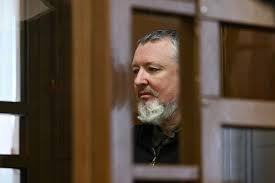
Russian losses per 04/10/24 reported by the Ukrainian general staff.
+1230 men
+15 tanks
+31 AFVs
+59 artillery pieces
+8(!) MLRS
+1 AD system
+101 UAVs

Great minds think alike
